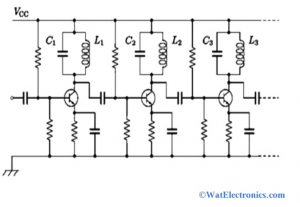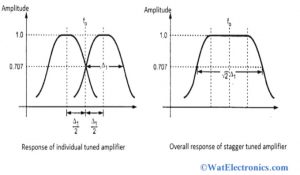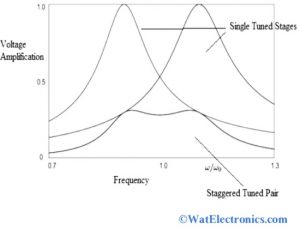The theory of modern electronics is based on amplification, which is achieved using the circuit called the amplifier circuit. As we know, the gain of the amplifier is not varied according to the signal frequency. Hence, to amplify and select the desired range of frequency a tuned amplifier circuit is needed. An amplifier circuit, which is used to amplify the desired range of frequency or a narrow band range of frequencies and rejects all other frequencies known as tuned amplifiers. To amplify the selected range of frequency, the load circuit of the amplifier acts as a tank circuit. There are different types of tuned amplifiers such as single tuned, double-tuned, and stagger tuned. Using the tuned amplifiers, high-frequency signals or RF signals are amplified. These are mostly used in radio receivers for amplification. This article describes the stagger tuned amplifier type and it’s working.
What is Stagger Tuned Amplifier?
Definition: To improve the overall frequency response of tuned amplifiers and indicate the minimal flatness around the center frequency of the signal, a tuned amplifier called stagger tuned amplifier is designed. The number of tuned circuits required to operate this type of tuned amplifier should be union.
The individual frequency responses of the tuned circuits are added to get the overall frequency response of this amplifier. In this type of tuned amplifier, resonant frequencies are altered or staggered. Hence it is known as a stagger tuned amplifier. It provides greater bandwidth. But the selectivity of the frequency and tuning of the tank circuit is difficult. It is mainly applicable in radio receivers of the RF amplifier stage.
As the operation of this circuit is represented using the rational function, the filter responses of Chebyshev and Butterworth filters can be derived. The separation of bandwidth is equal to the phase bandwidth of individual tuned circuits connected because the two resonant frequencies are staggered.
Stagger Tuned Amplifier Circuit
As we know that the double-tuned amplifier provides a greater bandwidth of 3dB with steeper sides and a flat top. But the alignment of the double-tuned amplifier is difficult. To solve this issue, it is necessary to cascade two single-tuned amplifiers with a certain bandwidth. The resonant frequencies of two single tuned cascaded amplifiers can be adjusted and separated by an amount, to produce the bandwidth that is equal to the bandwidth of individual stages. As the resonant frequencies are staggered or displaced, we call it a stagger-tuned amplifier.

Stagger Tuned Amplifier Circuit Diagram
A stagger tuned amplifier circuit design with two single-stage stagger cascaded amplifiers shown below. In this circuit, stagger tuning is done by resonating tuned circuits such as L1 C1 and L2 C2 to different frequencies slightly.
Stagger Tuned Amplifier Working
The stagger tuned amplifier working is explained with the help of amplification characteristics of two single tuned cascaded amplifiers and the staggered pair amplification characteristics of the two stages. The frequency response between the overall response of the two-stage amplifier and individual two-stage single tuned cascaded amplifier in stagger tuned amplifier is shown below
Due to the staggering of resonant frequencies, the total amplification of the center frequency is reduced to 0.5 of the peak amplification of the individual stages of this amplifier. At the center frequency, the amplification factor of individual stages is 0.707 of the peak amplification factor of the individual stages in stagger tuned amplifiers. Hence the equivalent amplification factor per stage of the staggered tuned amplifier is 0.707 times greater only when the same two stages of single tuned amplifiers are used without staggering.

Frequency Response
Here, the 3dB bandwidth (half-power bandwidth) of the staggered pair is 1.414 times (√2 times) greater than the 3dB bandwidth of an individual single tuned amplifier. Hence the gain-bandwidth product of each stage of a staggered tuned amplifier or staggered pair is 0.707 x √2 = 1.0 times greater than that of an individual single tuned amplifier.
It is easy to implement staggered tuned amplifiers with multiple stages. For example, in a three-stage single tuned amplifier, the first tuning circuit is tuned to a lower frequency than the center frequency, the third tuning circuit should have a higher frequency than center frequency and the second tuning circuit should have frequency same as the center frequency.

Characteristics of Stagger Tuned Amplifier
Stagger Tuned Amplifier Derivation
The derivation of this amplifier is explained below.
The gain of the single tuned amplifier is given as,
Av / (Av at resonance) = 1 / (1+2jQeffδ) =1/(1+jx)
Since X= 2jQeffδ
In a staggered tuned amplifier, the two single tuned cascaded amplifiers with separate resonant frequencies are used.
Let us consider one stage of stagger tuned amplifier is tuned to (fr + δ) frequency and the other stage is tuned to (fr – δ)
That means, fr1 = (fr + δ) and fr2 = (fr – δ)
The selectivity functions for these tuned frequencies are given as,
Av / (Av at resonance)1 = 1/(1+j(x+1)) and
Av / (Av at resonance)2= 1/(1+j(x-1))
The product of individual gains of two single tuned amplifiers gives the overall gain.
Av / (Av at resonance) cascaded = Av / (Av at resonance)1 X Av / (Av at resonance)2
= 1/(1+j(x+1)) x 1/(1+j(x-1))= 1/(2+2jx-x^2)
= 1/((2-x^2) +2jx))
Therefore, the overall gain is calculated as,
|Av / (Av at resonance) cascaded| = 1/(√(2-x^2) ^2+2x^2) = 1/(√(4+x^2)
Substitute the value of X= 2jQeffδ in the above equation. Then we get,
|Av / (Av at resonance) cascaded|= 1/√(4+(2jQeffδ) ^4) = 1/2(√(1+4Qeff^4δ^4)
Please refer to this link to know more about transistor tuned amplifiers MCQs
Applications
The stagger tuned amplifier applications are given below,
- These type of tuned amplifiers are employed in wideband applications for the amplification of videos
- Used as an IF amplifiers in the superheterodyne receiver, TV receiver, and satellite transponder
- Easy to implement and spread component values in various integrated circuits
- Used in wireless local area networks (WLANs)
- Used in RF amplifier for radio applications like radio receivers
- Used for Y- amplifiers for oscilloscope working
- Used in various industrial applications
- Used as a narrow-band IF amplifier within the spectrum analyzer
- Used in radio UHF relay systems
Advantages & Disadvantages
The stagger tuned amplifier advantages are
- The tuning of this amplifier is very easy
- It has better flat wideband characteristics
- The bandwidth is increased √2 times when compared to a single tuned amplifier
- The overall gain is increased due to the cascading of two single tuned amplifiers
- Enhanced stability of the circuit
The stagger tuned amplifier disadvantages are
- The alignment of stagger-tuned amplifiers is difficult. Hence, two single-tuned amplifiers are cascaded.
- The selectivity is reduced and the tuning of tank circuits is critical.
Please refer to this link to know more about Klystron Amplifier & Inverting Amplifier Circuit.
Please refer to this link to know more about Audio amplifier.
Know more about Multi Stage Transistor Amplifier MCQs & Single Stage Transistor Amplifier MCQ’s.
Thus, this is all about an overview of the stagger tuned amplifier – definition, circuit diagram, working, derivation, applications, advantages, and disadvantages. This type of amplifier is designed to obtain better flat wideband frequency response characteristics equal to the center frequency. Here is a question for you,” What is the importance of a stagger tuned amplifier?”